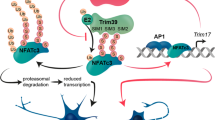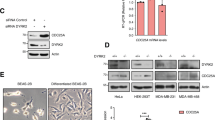Abstract
The transcription factor E2F1 has pivotal roles in both cell proliferation and cell death, and is an important molecular target in cancer. Under proliferative conditions E2F1 induces the expression of genes that promote cell cycle progression, such as E2F2, whereas under proapoptotic conditions E2F1 induces expression of genes such as p73 that lead to apoptosis. The mechanism by which the apoptotic function of E2F1 is activated remains unclear, however. We now show that members of the E2F family are covalently conjugated with the ubiquitin-like modifier NEDD8. Overexpression of SENP8, a NEDD8-specific cysteine protease, resulted in deNEDDylation of E2F1 and promoted its transactivation activity at the p73 gene but not at the E2F2 gene. Knockdown of SENP8, on the other hand, attenuated p73 expression and apoptosis induced by E2F1 or by DNA damage. SENP8 also promoted the interaction between E2F1 and its cofactor Microcephalin 1, which is required for p73 induction. These results suggest that NEDDylation is a molecular trigger that modifies the target specificity of E2F1, and could have important implications for E2F1 regulation of apoptosis.
This is a preview of subscription content, access via your institution
Access options
Subscribe to this journal
Receive 50 print issues and online access
$259.00 per year
only $5.18 per issue
Buy this article
- Purchase on Springer Link
- Instant access to full article PDF
Prices may be subject to local taxes which are calculated during checkout









Similar content being viewed by others
References
van den Heuvel S, Dyson NJ . Conserved functions of the pRB and E2F families. Nat Rev Mol Cell Biol 2008; 9: 713–724.
Iaquinta PJ, Lees JA . Life and death decisions by the E2F transcription factors. Curr Opin Cell Biol 2007; 19: 649–657.
DeGregori J, Johnson DG . Distinct and overlapping roles for e2f family members in transcription, proliferation and apoptosis. Curr Mol Med 2006; 6: 739–748.
Rowland BD, Bernards R . Re-evaluating cell-cycle regulation by E2Fs. Cell 2006; 127: 871–874.
Wu L, Timmers C, Maiti B, Saavedra HI, Sang L, Chong GT et al. The E2F1-3 transcription factors are essential for cellular proliferation. Nature 2001; 414: 457–462.
Chong J-L, Wenzel PL, Saenz-Robles MT, Nair V, Ferrey A, Hagan JP et al. E2f1-3 switch from activators in progenitor cells to repressors in differentiating cells. Nature 2009; 462: 930–934.
Chen D, Pacal M, Wenzel P, Knoepfler PS, Leone G, Bremner R . Division and apoptosis of E2f-deficient retinal progenitors. Nature 2009; 462: 925–929.
Stiewe T, Putzer BM . Role of the p53-homologue p73 in E2F1-induced apoptosis. Nat Genet 2000; 26: 464–469.
Lissy NA, Davis PK, Irwin M, Kaelin WG, Dowdy SF . A common E2F-1 and p73 pathway mediates cell death induced by TCR activation. Nature 2000; 407: 642–645.
Irwin M, Marin MC, Phillips AC, Seelan RS, Smith DI, Liu W et al. Role for the p53 homologue p73 in E2F-1-induced apoptosis. Nature 2000; 407: 645–648.
Hershko T, Ginsberg D . Up-regulation of Bcl-2 homology 3 (BH3)-only proteins by E2F1 mediates apoptosis. J Biol Chem 2004; 279: 8627–8634.
Biswas SC, Liu DX, Greene LA . Bim is a direct target of a neuronal E2F-dependent apoptotic pathway. J Neurosci 2005; 25: 8349–8358.
Moroni MC, Hickman ES, Denchi EL, Caprara G, Colli E, Cecconi F et al. Apaf-1 is a transcriptional target for E2F and p53. Nat Cell Biol 2001; 3: 552–558.
Nahle Z, Polakoff J, Davuluri RV, McCurrach ME, Jacobson MD, Narita M et al. Direct coupling of the cell cycle and cell death machinery by E2F. Nat Cell Biol 2002; 4: 859–864.
Hallstrom TC, Nevins JR . Jab1 is a specificity factor for E2F1-induced apoptosis. Genes Dev 2006; 20: 613–623.
Hallstrom TC, Nevins JR . Specificity in the activation and control of transcription factor E2F-dependent apoptosis. Proc Nat Acad Sci USA 2003; 100: 10848–10853.
Lazzerini Denchi E, Helin K . E2F1 is crucial for E2F-dependent apoptosis. EMBO Rep 2005; 6: 661–668.
Martinez LA, Goluszko E, Chen H-Z, Leone G, Post S, Lozano G et al. E2F3 is a mediator of dna damage-induced apoptosis. Mol Cell Biol 2010; 30: 524–536.
Lin WC, Lin FT, Nevins JR . Selective induction of E2F1 in response to DNA damage, mediated by ATM-dependent phosphorylation. Genes Dev 2001; 15: 1833–1844.
Stevens C, Smith L, La Thangue NB . Chk2 activates E2F-1 in response to DNA damage. Nat Cell Biol 2003; 5: 401–409.
Urist M, Tanaka T, Poyurovsky MV, Prives C . p73 induction after DNA damage is regulated by checkpoint kinases Chk1 and Chk2. Genes Dev 2004; 18: 3041–3054.
Pediconi N, Ianari A, Costanzo A, Belloni L, Gallo R, Cimino L et al. Differential regulation of E2F1 apoptotic target genes in response to DNA damage. Nat Cell Biol 2003; 5: 552–558.
Yang SZ, Lin FT, Lin WC . MCPH1/BRIT1 cooperates with E2F1 in the activation of checkpoint, DNA repair and apoptosis. EMBO Rep 2008; 9: 907–915.
Rabut G, Peter M . Function and regulation of protein neddylation. 'Protein modifications: beyond the usual suspects' review series. EMBO Rep 2008; 9: 969–976.
Watson IR, Li BK, Roche O, Blanch A, Ohh M, Irwin MS . Chemotherapy induces NEDP1-mediated destabilization of MDM2. Oncogene 2009; 29: 297–304.
Hofmann F, Martelli F, Livingston DM, Wang Z . The retinoblastoma gene product protects E2F-1 from degradation by the ubiquitin-proteasome pathway. Genes Dev 1996; 10: 2949–2959.
Hateboer G, Kerkhoven RM, Shvarts A, Bernards R, Beijersbergen RL . Degradation of E2F by the ubiquitin-proteasome pathway: regulation by retinoblastoma family proteins and adenovirus transforming proteins. Genes Dev 1996; 10: 2960–2970.
Rizos H, Woodruff S, Kefford RF . p14 ARF interacts with the SUMO-conjugating enzyme Ubc9 and promotes the sumoylation of its binding partners. Cell Cycle 2005; 4: 597–603.
Soucy TA, Smith PG, Milhollen MA, Berger AJ, Gavin JM, Adhikari S et al. An inhibitor of NEDD8-activating enzyme as a new approach to treat cancer. Nature 2009; 458: 732–736.
Stickle NH, Chung J, Klco JM, Hill RP, Kaelin WG, Ohh M . pVHL modification by nedd8 is required for fibronectin matrix assembly and suppression of tumor development. Mol Cell Biol 2004; 24: 3251–3261.
Xirodimas DP, Saville MK, Bourdon J-C, Hay RT, Lane DP . Mdm2-mediated NEDD8 conjugation of p53 inhibits its transcriptional activity. Cell 2004; 118: 83.
Watson IR, Blanch A, Lin DCC, Ohh M, Irwin MS . Mdm2-mediated NEDD8 modification of TAp73 regulates its transactivation function. J Biol Chem 2006; 281: 34096–34103.
Gao F, Cheng J, Shi T, Yeh ETH . Neddylation of a breast cancer-associated protein recruits a class III histone deacetylase that represses NF[kappa]B-dependent transcription. Nat Cell Biol 2006; 8: 1171–1177.
Xirodimas DP, Sundqvist A, Nakamura A, Shen L, Botting C, Hay RT . Ribosomal proteins are targets for the NEDD8 pathway. EMBO Rep 2008; 9: 280–286.
Hughes TA, Brady HJM . E2F1 up-regulates the expression of the tumour suppressor axin2 both by activation of transcription and by mRNA stabilisation. Biochem Biophys Res Commun 2005; 329: 1267–1274.
Morris EJ, Ji J-Y, Yang F, Di Stefano L, Herr A, Moon N-S et al. E2F1 represses [bgr]-catenin transcription and is antagonized by both pRB and CDK8. Nature 2008; 455: 552–556.
Wu S, Murai S, Kataoka K, Miyagishi M . Yin Yang 1 induces transcriptional activity of p73 through cooperation with E2F1. Biochem Biophys Res Commun 2008; 365: 75–81.
Ianari A, Gallo R, Palma M, Alesse E, Gulino A . Specific role for p300/CREB-binding protein-associated factor activity in E2F1 stabilization in response to DNA damage. J Biol Chem 2004; 279: 30830–30835.
Marzio G, Wagener C, Gutierrez MI, Cartwright P, Helin K, Giacca M . E2F family members are differentially regulated by reversible acetylation. J Biol Chem 2000; 275: 10887–10892.
Martinez-Balbas MA, Bauer UM, Nielsen SJ, Brehm A, Kouzarides T . Regulation of E2F1 activity by acetylation. Embo J 2000; 19: 662–671.
Vousden KH, Lu X . Live or let die: the cell's response to p53. Nat Rev Cancer 2002; 2: 594–604.
Wang B, Liu K, Lin FT, Lin WC . A role for 14-3-3 tau in E2F1 stabilization and DNA damage-induced apoptosis. J Biol Chem 2004; 279: 54140–54152.
Rogoff HA, Pickering MT, Frame FM, Debatis ME, Sanchez Y, Jones S et al. Apoptosis associated with deregulated E2F activity is dependent on E2F1 and Atm/Nbs1/Chk2. Mol Cell Biol 2004; 24: 2968–2977.
Field SJ, Tsai FY, Kuo F, Zubiaga AM, Kaelin WG, Livingston DM et al. E2F-1 functions in mice to promote apoptosis and suppress proliferation. Cell 1996; 85: 549–561.
Yamasaki L, Jacks T, Bronson R, Goillot E, Harlow E, Dyson NJ . Tumor induction and tissue atrophy in mice lacking E2F-1. Cell 1996; 85: 537–548.
Polager S, Ginsberg D . E2F - at the crossroads of life and death. Tr Cell Biol 2008; 18: 528–535.
Engels IH, Daguia C, Huynh T, Urbina H, Buddenkotte J, Schumacher A et al. A time-resolved fluorescence resonance energy transfer-based assay for DEN1 peptidase activity. Anal Biochem 2009; 390: 85–87.
Morita S, Kojima T, Kitamura T . Plat-E: an efficient and stable system for transient packaging of retroviruses. Gene Ther 2000; 7: 1063–1066.
Treier M, Staszewski LM, Bohmann D . Ubiquitin-dependent c-Jun degradation in vivo is mediated by the delta domain. Cell 1994; 78: 787–798.
Acknowledgements
We thank Dr Elizabeth Nigh and colleagues for critical reading of the manuscript. This work was supported by Grants-in-Aid for Scientific Research (A) from the Ministry of Education, Culture, Sports, Science and Technology (MEXT) of Japan, and by CREST from the Japan Science and Technology Agency. This work was also supported in part by the Global COE Program (Integrative Life Science Based on the Study of Biosignaling Mechanisms), MEXT, Japan.
Author information
Authors and Affiliations
Corresponding author
Ethics declarations
Competing interests
The authors declare no conflict of interest.
Additional information
Supplementary Information accompanies the paper on the Oncogene website
Rights and permissions
About this article
Cite this article
Aoki, I., Higuchi, M. & Gotoh, Y. NEDDylation controls the target specificity of E2F1 and apoptosis induction. Oncogene 32, 3954–3964 (2013). https://doi.org/10.1038/onc.2012.428
Received:
Revised:
Accepted:
Published:
Issue Date:
DOI: https://doi.org/10.1038/onc.2012.428
Keywords
This article is cited by
-
Inhibition of neddylation facilitates cell migration through enhanced phosphorylation of caveolin-1 in PC3 and U373MG cells
BMC Cancer (2018)
-
The E3 ligase C-CBL inhibits cancer cell migration by neddylating the proto-oncogene c-Src
Oncogene (2018)
-
DNA damage and S phase-dependent E2F1 stabilization requires the cIAP1 E3-ubiquitin ligase and is associated with K63-poly-ubiquitination on lysine 161/164 residues
Cell Death & Disease (2017)
-
NEDDylation antagonizes ubiquitination of proliferating cell nuclear antigen and regulates the recruitment of polymerase η in response to oxidative DNA damage
Protein & Cell (2017)
-
Neddylation controls basal MKK7 kinase activity in breast cancer cells
Oncogene (2016)



